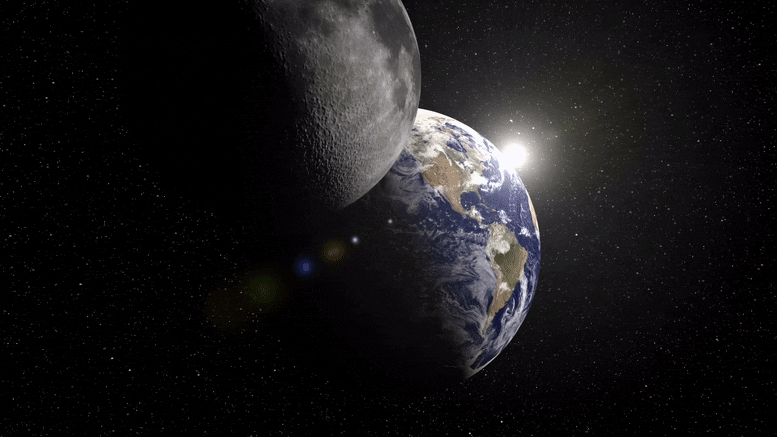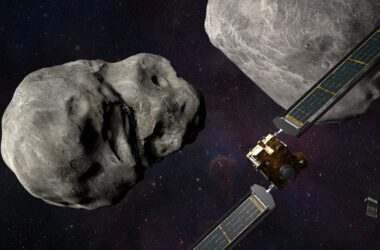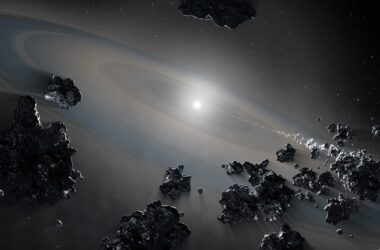Des chercheurs de l’UAB, de l’IFAE et de l’University College London proposent d’utiliser les variations de distance entre la Terre et la Lune, qui peuvent être mesurées avec une précision de moins d’un centimètre, comme nouveau détecteur d’ondes gravitationnelles dans une gamme de fréquences que les dispositifs actuels ne peuvent pas détecter. Ces recherches, qui pourraient ouvrir la voie à la détection de signaux provenant des premiers instants de l’univers, ont été publiées récemment dans la revue Physical Review Letters.
Les ondes gravitationnelles, prédites par Albert Einstein au début du XXe siècle et détectées pour la première fois en 2015, sont les nouveaux messagers des processus les plus violents qui se déroulent dans l’univers. Les détecteurs d’ondes gravitationnelles balaient différentes gammes de fréquences, un peu comme on déplace un cadran lorsqu’on se branche sur une station de radio. Néanmoins, il existe des fréquences qu’il est impossible de couvrir avec les appareils actuels et qui peuvent abriter des signaux fondamentaux pour la compréhension du cosmos. Un exemple particulier est celui des ondes microhertz, qui pourraient avoir été produites à l’aube de notre univers, et qui sont pratiquement invisibles, même pour les technologies les plus avancées disponibles aujourd’hui.
Dans un article récemment publié dans la prestigieuse revue Physical Review Letters, les chercheurs Diego Blas, du département de physique de l’Universitat Autònoma de Barcelona (UAB) et de l’Institut de Física d’Altes Energies (IFAE), et Alexander Jenkins, de l’University College London (UCL), soulignent qu’un détecteur naturel d’ondes gravitationnelles existe dans notre environnement immédiat : le système Terre-Lune. Le gravitational waves constantly hitting this system generate tiny deviations in the Moon’s orbit. Although these deviations are minute, Blas and Jenkins plan on taking advantage of the fact that the Moon’s exact position is known with an error of at most one centimeter, thanks to the use of lasers sent from different observatories which are continuously reflected upon mirrors left on the surface of the Moon by the Apollo space mission and others. This incredible precision, with an error of one billionth of a part at most, is what may allow a small disturbance caused by ancient gravitational waves to be detected. The Moon’s orbit lasts approximately 28 days, which translates into a particularly relevant sensitivity when it comes to microhertz, the frequency range researchers are interested in.
Similarly, they also propose using the information other binary systems in the universe may provide as gravitational wave detectors. This is the case of pulsar binary systems distributed throughout the galaxy, systems in which the pulsar’s radiation beam allows obtaining the orbit of these stars with incredible precision (with a precision of one millionth). Given that these orbits last approximately 20 days, the passing of gravitational waves in the microhertz frequency range affect them particularly. Blas and Jenkins concluded that these systems could also be potential detectors of these types of gravitational waves.
With these “natural detectors” in the microhertz frequency range, Blas and Jenkins were able to propose a new form of studying gravitational waves emitted by the distant universe. Specifically, those produced by the possible presence of transitions in highly energetic phases of the early universe, commonly seen in many models.
“What is most interesting perhaps is that this method complements future ESA/NASA missions, such as LISA, and observatories participating in the Square Kilometer Array (SKA) project, to reach an almost total coverage of the gravitational waves from the nanohertz (SKA) to the centihertz (LIGO/VIRGO) frequency ranges. This coverage is vital to obtaining a precise image of the evolution of the universe, as well as its composition”, Diego Blas explains. “Covering the microhertz frequency range is a challenge, which now may be feasible without the need of building new detectors, and only observing the orbits of systems we already know. This connection between fundamental aspects of the universe and more mundane objects is particularly fascinating and can eventually lead to the detection of the earliest signals we have ever seen, and thus change what we know about the cosmos”, he concludes.
Reference: “Bridging the μHz Gap in the Gravitational-Wave Landscape with Binary Resonances” by Diego Blas and Alexander C. Jenkins, 11 March 2022, Physical Review Letters.
DOI: 10.1103/PhysRevLett.128.101103



